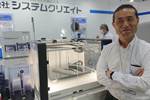Anisoprint R&D team begins 3D printing center at Jacobs University Bremen
Established research environment to comprehensively upgrade CFC technology, explore new composites methods, formulations and designs.
Anisoprint R&D team at Jacobs University in Bremen. Left to right: Artemy Naumov, Alexander Kochetkov, Georgy Nurtdinov, Andrey Emelyanov. Photo Credit: Anisoprint
Starting in September 2022, 3D printing solution provider Anisoprint (Esch-sur-Alzette, Luxembourg) deployed its research and development (R&D) team at . The main focus of the partnership is to foster R&D of composites manufacturing with the company’s continuous fiber co-extrusion (CFC) technology and establish a research environment for 3D printing technologies on the university campus in Bremen, Germany.
Following the between Anisoprint and Jacobs University, the startup team moved their R&D operations to Bremen in early September. Starting off in full momentum, the Anisoprint group has already took part in at Jacobs University, an initiative that presents the diverse array of research taking place at the university, particularly highlighting research opportunities for students.
Among the goals set with Jacobs University is the development of collaborative projects aimed at improving Anisoprint’s proprietary CFC technology, fiber layup control methods, and printing process analysis. Projects will also focus on the chemical modification of materials used in CFC technology.
In 2023, Anisoprint plans to establish an internship program for university students to develop educational activities in additive technology, polymer physics and chemistry, and composite mechanics. Plans also entail getting students involved in international and European research projects, creating entirely new opportunities for students at Jacobs University.
“Within this cooperation, we plan to further develop fiber layering techniques and create adhesive formulations for a quality CFC technology upgrade,” Alexander Kochetkov, head of R&D, adds.
Anisoprint’s commercial R&D agenda includes:
- Improving and equipping the 3D printing laboratory for proper study of the properties of composite materials;
- Exploration of new methods of carbon fiber impregnation with resins and thermoplastic polymers;
- Improving the binder formulation used in CFC technology.
In addition, research on the physical-chemical and mechanical properties of plastics used in printing and composite materials includes conducting tests with various types of plastics and fibers applicable in CFC technology for their subsequent commercial success.
The overall collaboration project is reported to be comprehensive, with the goal of improving current print quality and modernization of the process, developing new technologies and patent work; it will also enable participation in EU startup programs, grants and projects.
“We are excited to welcome Anisoprint’s R&D team on campus,” Fabio Pammolli, president of Jacobs University, says. “In addition to developing new materials, improving processes and design methods, the team will also provide excellent research and training opportunities for our students.”
Related Content
-
AIMM Center for advanced composites NDT opens in Ogden, Utah
Attendees from SpaceX, Northrop Grumman, Hill AFB, 47G and others joined CICNDT and Omni NDE to demonstrate the latest in robotic CT, RT, shearography, thermography, laser UT and metrology.
-
Determining steel/composite failure load of bonded repair assemblies
Bureau Veritas and partners use a novel equivalent interface test specimen and simulation to predict failure load in bonded composite patch repairs to steel structures.
-
Schrödinger advances materials informatics for faster development of next-gen composites
Cutting time to market by multiple orders of magnitude, machine learning and physics-based approaches are combined to open new possibilities for innovations in biomaterials, fire-resistant composites, space applications, hydrogen tanks and more.






